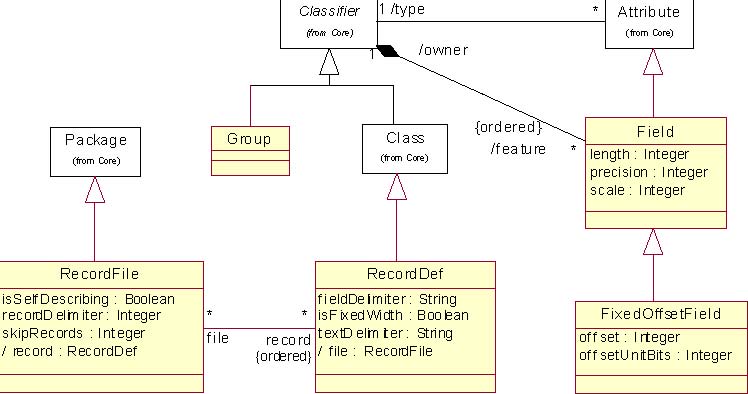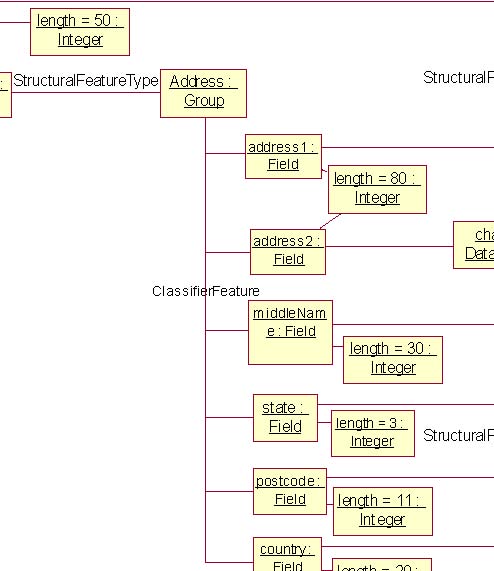
| Previous | Table of Contents | Next |
The Record package depends on the following packages: • org.omg::CWM::ObjectModel::Core • org.omg::CWM::ObjectModel::Instance
Because of the antiquity of many record-based models, individual system implementations employing record models may have unusual
features (such as occurs-depending arrays, various COBOL rename/remapping semantics, etc.) that are not shared with other
implementations. When such features are limited to single implementations or languages, they have been purposefully left out
of the Record metamodel. Rather, unusual features of this sort should be placed into extension packages designed to meet the
needs of those implementations or languages. For example, record structuring features endemic to the COBOL language have been
placed in the COBOLData metamodel in the CWMX package described in Volume 2 and do not appear here. In this way, COBOL-only
features do not burden other record oriented implementations unnecessarily.
The Record metamodel appears
in Figure 7-1
.

Figure 7-1 Record Package
The instance diagram in
Figure 7-2
shows how a record description is represented in this model. The record contains three fields, one of which is a group item
that itself has embedded fields. The main RecordDef is named Customer. It contains three Fields: account, custName, and custAddress.
Customer :RecordDef
account : StructuralFeatureType long :
Field DataType

state : Field length = 3 : Integer StructuralFeatureType
custAddress : StructuralFeatureType Address : StructuralFeatureType Field Group
ClassifierFeature
custName :Field length = 50 :Integer

address1 : Field length = 80 : Integer
char :
address2 : Field DataType
middleNam
e : Field
length = 30 : Integer
postcode : Field length = 11 : Integer
country :
Field length = 20 : Integer
Figure 7-2 Record metamodel instance example
The account is a numeric field with a type of long, which is an instance of DataType. Size information about the field --
its length, precision, and scale -- are not relevant for the long data type.
The field custName has a type of char, which is another instance of DataType. The field is 50 characters in length but needs
no precision or scale information.
Field custAddress is a single field; its internal structure is determined from its type Address, an instance of Group containing
six fields.
• address1 and address2 have type of char and are 80 characters long.
• city is also of type char but is 30 characters long.
• state, postcode, and country are of the type char as well but are 3, 11, and 20 characters long, respectively.
The following text shows how the example RecordDef would be described in three widely used programming languages.
C Programming Language
typedef struct Address { char address1[80]; char address2[80]; char city[30]; char state[3]; char postcode[11]; char country[20];
} Address;
typedef struct Customer { long account; char custName[50]; Address custAddress;
} Customer; Customer cust;
COBOL Programming Language
01 Customer. 05 account PIC 999999
USAGE BINARY. 05 custName PIC X(50). 05 custAddress.
10 address1 PIC X(80). 10 address2 PIC X(80). 10 city PIC X(30). 10 state PIC X(3). 10 postcode PIC X(11). 10 country PIC X(20).
PL/1 Programming Language
DECLARE
1 CUSTOMER , 2 ACCOUNT FIXED BIN(31,0), 2 CUSTNAME CHAR(50), 2 CUSTADDRESS,
3 ADDRESS1 CHAR(80), 3 ADDRESS2 CHAR(80), 3 CITY CHAR(30), 3 STATE CHAR(3), 3 POSTCODE CHAR(11), 3 COUNTRY CHAR(20);